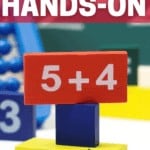Teaching Abstract Concepts with the Singapore Math Learning Method
The Fervent Mama uses Affiliate Links. See our disclosure policy here.
This post has been sponsored by Singapore Math Learning Center. All opinions are my own.
Is your child having difficulty grasping certain abstract concepts? What about teaching abstract concepts in your homeschool? Math can be especially difficult for some children to grasp because they are so abstruse, but there is an easy way to bridge the gap!
When teaching conceptual ideas, sometimes we need a little help to connect these abstract theories, and making them come alive through concrete evidence can be key in mastering them!
If you haven’t heard of the Singapore Math Learning Method, it could be just what you’re looking for to make learning come alive in your homeschool!
Teaching Abstract Concepts with the Singapore Math Learning Method
These three steps can be literal stepping stones that help make those connections that will help them thrive in learning!
Singapore Math Learning Center says…
The Singapore Math [Learning] Method uses the concrete to pictorial to abstract learning approach to encourage active thinking, understanding, and communication of mathematical concepts and problem-solving.
This proven method has been adopted by parents and schools in the United States and around the world and has helped students understand and excel in mathematics.

The Singapore Math Learning Method uses the CPA method at its core; Concrete, Pictorial, Abstract. Using this method helps to provide the student with the building blocks of concepts all the way through mastery!
1. Start with Physical (Concrete) Objects
Think of creative ways to put whatever abstract concept you’re studying into concrete form. This can be done in a variety of ways. Acting out, using physical items, manipulatives, consumables- make what you have work for you!
This is a great way to include hands-on activities in your Math lessons. Mathematics can be a fickle thing and hard to understand for some.
If you are teaching addition to a child and they don’t understand what addends and sums are, put those concepts into concrete form by using objects (ex. 2 groups of 2 apples). Let your child create their own groups (addends) and put them together and count them up thus creating their own sums.
If they have favorite cars, LEGOs, or mini-figures; you might use those as props. Getting to “play” with favorite toys while learning a hard concept makes it somewhat easier and definitely more fun.
This might also be a fun activity to do around snack time. Your child could create groups of snacks for everyone in the family and then add up how much you are eating altogether.
2. Exchange Concrete Objects for Pictures
Once your child has a good grasp on the concept you are wanting to teach using physical objects, it’s time to exchange those physical objects for pictures. It would be good to try to find some worksheets with the same sort of objects your child has been working with.
You could also bridge any gaps by first building a problem with physical objects (be that 2+2 with apples or cars, even using physical people and actions) and then drawing that same problem on paper.
If your child likes to draw, this could be a very fun exercise. However, if your child doesn’t enjoy drawing, you could use stickers or pictures you’ve printed and cut out to create problems on paper.

3. Graduating to Abstract Symbols
Exchanging pictures for symbols and words clicks with some children right away, but can pose a real challenge for others. If your child is having trouble with understanding abstract symbols, try going all the way back to the concrete and beginning again.
Build your problem with physical objects, exchange your objects for pictures, and then exchange those pictures for symbols. Repeat this process over and over until the concept becomes clear to your child.
If you or your child becomes too frustrated, it may be time to take a break. Sometimes taking a week off from a concept and revisiting it later helps the brain relax and grasp the concept.
Teaching abstract concepts can be time-consuming at times, but the reward of seeing your child understand something he could not before is unmatched!
If you feel ill-equipped, you don’t have to do it all alone. Help your struggling learner by consulting with the Singapore Math Learning Center! Singapore Math Learning Center has been a trusted Mathematics Tutoring Source since 2013 and is currently ranked with the top 100 Educational Resources from Homeschool.com!
Need a little extra financial help to provide your homeschool with some consumables and manipulatives? Singapore Math Learning Center is offering one of our readers a $50 Amazon Gift Card! Enter to win, today!
Do you use the Singapore Math Learning Method? How has it transformed your homeschool?

This article is a part of our How We Homeschool Series; a collection of content from full-time, veteran homeschoolers sharing their own experiences on the versatility and diversity of homeschooling. You can read more about the series, and see all of the content, by clicking the image below.













